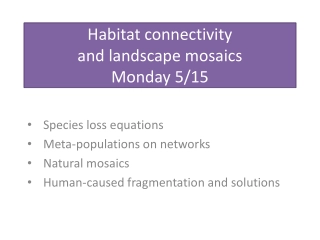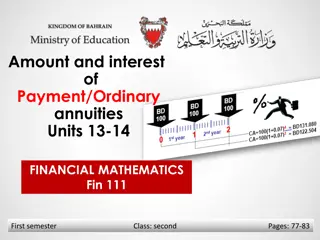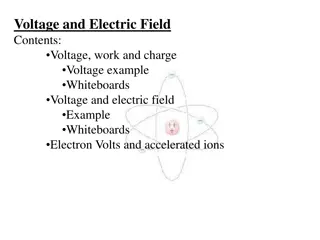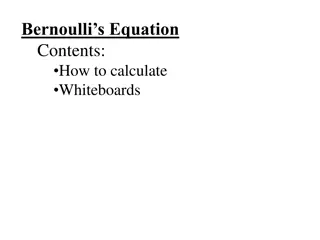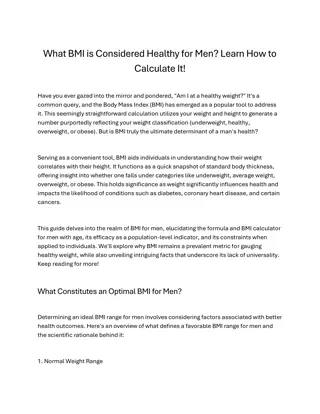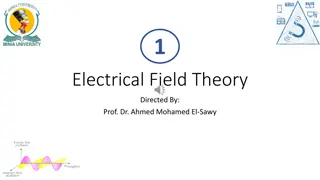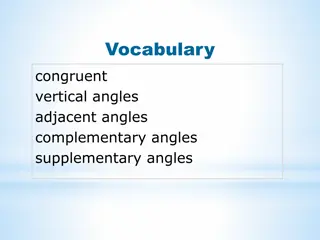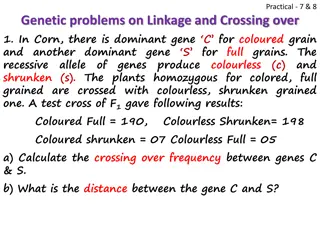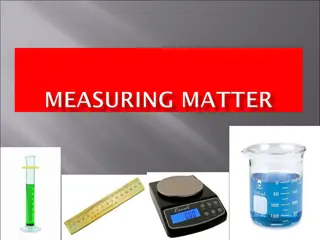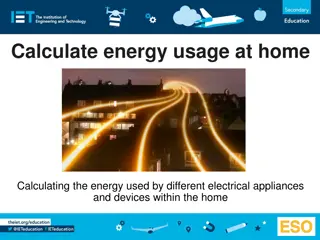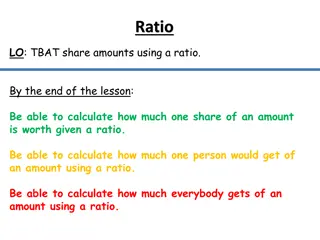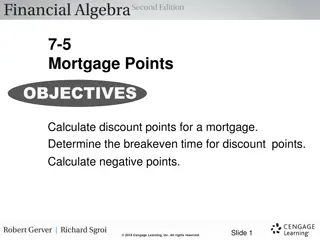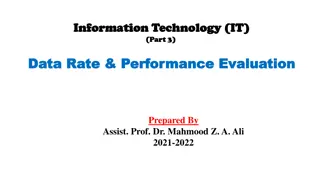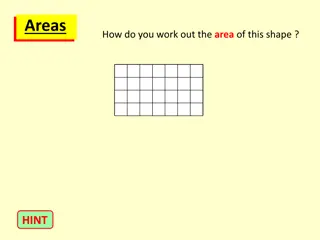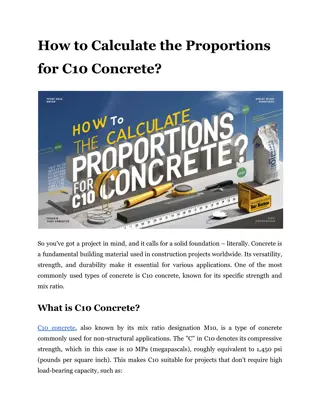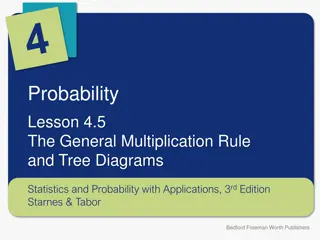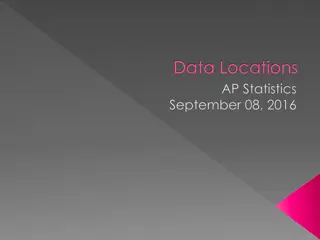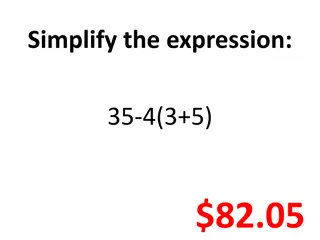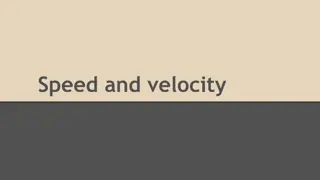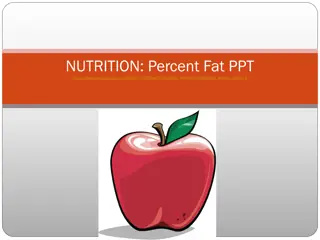Facilities Improvement Fund (FIF): Tax Implications
Learn how Facilities Improvement Fund (FIF) grants impact taxable income for home-based child care providers in this informative webinar. Find out how to calculate taxable income and make informed financial decisions. Presenter: Margie Cangelosi, E.A.
0 views • 25 slides
Understanding Habitat Connectivity and Landscape Mosaics
Explore the importance of habitat connectivity, landscape mosaics, and metapopulations in preserving biodiversity. Delve into species loss equations, natural mosaics, and human-caused fragmentation, along with solutions. Review concepts related to optimizing land use for biodiversity and economic in
0 views • 40 slides
Cost-Benefit Analysis Template for Project Evaluation
This template for cost-benefit analysis in PowerPoint allows you to assess the economic viability of a proposed project compared to alternative options. It provides a structured approach to list benefits, rank impact, evaluate costs, and calculate the ratio between benefits and costs. Share this ana
2 views • 4 slides
Apprenticeship Math Questions: Calculate the Benefits!
Work through a series of apprenticeship-related math questions involving apprenticeship program numbers, clothing purchases, banana costs, gardening areas, ferry car capacities, and interview day calculations. Test your math skills and learn the practical applications of math in apprenticeship scena
1 views • 8 slides
Financial Mathematics: Amount and Interest of Payment in Ordinary Annuities
Learn about ordinary annuities, including how to calculate compound amounts and compound interest in payment schedules. Explore formulas and examples to understand the concept deeply.
3 views • 28 slides
Variance Analysis and Standard Costing in Business
Explore the concepts of standard costs, budgeted costs, and variance analysis in business. Understand the importance of investigating variances and learn to calculate and interpret different types of variances like material price, labor efficiency, and overhead volume variances.
5 views • 52 slides
Understanding Voltage and Electrical Potential in Physics
Explore the concepts of voltage, electrical potential, work, and charge through practical examples involving moving charges against electric and gravitational fields. Learn how to calculate voltage, work done, and gravitational potential changes in various scenarios. Dive into the world of electrica
3 views • 23 slides
Understanding Half-Life in Physics
Half-life is a key concept in physics, particularly in radioactive decay. It is the time taken for the activity of a radioactive source to decrease to half of its original value. This can be determined experimentally through measuring counts per minute and graphing the data. Additionally, half-life
2 views • 11 slides
Understanding Fluid Pressure in Oil Field Hydraulics
Explore the fundamentals of fluid pressure including pressure basics, unit conversion, fluid weight constants, true vertical depth, and hydrostatic pressure in the context of oil and gas technology programs. Learn how to calculate pressure gradients, understand the impact of fluid density on pressur
1 views • 40 slides
Reservoir Storage-Yield Analyses Using HEC-ResSim Lecture #2
This lecture covers the theory of storage-yield analyses, focusing on understanding yield, types of yield like firm yield, methods to calculate yield, and the importance of storing water for re-distribution. It delves into within-year and over-year reservoir storage concepts, illustrating the minimu
7 views • 47 slides
Physics Problem-Solving: Kinematics, Dynamics, and Laser Energy
Explore various physics problems involving linear kinematics, 2-dimensional motion, dynamics, laser energy, and more. Learn how to calculate velocities, distances, forces, energies, and photon properties in different scenarios.
5 views • 22 slides
Understanding Bernoulli's Equation in Fluid Mechanics
Bernoulli's equation, a fundamental principle in fluid dynamics, relates pressure, kinetic energy, and potential energy of a fluid flowing in a pipe. Through examples and explanations, explore how this equation can be used to calculate velocity, pressure differences, and forces in various scenarios
1 views • 12 slides
What BMI is Considered Healthy for Men? Learn How to Calculate It!
Have you ever gazed into the mirror and pondered, \"Am I at a healthy weight?\" It's a common query, and the Body Mass Index (BMI) has emerged as a popular tool to address it. This seemingly straightforward calculation utilizes your weight and height to generate a number purportedly reflecting your
3 views • 5 slides
Understanding Optical Fiber Signal Degradation in Communication Engineering
Technocrats Institute of Technology (Excellence) in Bhopal delves into the concepts of signal degradation in optical fiber communication, focusing on attenuation, distortion mechanisms, and measurement techniques. The institute emphasizes the importance of signal attenuation and its impact on inform
4 views • 56 slides
Understanding Chemical Quantities: The Mole and Molar Mass
Explore the concept of chemical quantities through the mole and molar mass. Learn how to measure substances, calculate moles, find molar masses of compounds, and solve related problems in this informative chapter. Discover the significance of Avogadro's number, representative particles, and more in
9 views • 41 slides
Electrical Field Theory: Vector Analysis in Different Coordinate Systems
Explore the principles of Vector Analysis in Cartesian, Cylindrical, and Spherical coordinate systems as applied to Electrical Field Theory. Learn how to calculate differential lengths, areas, and volumes, and solve practical examples under the guidance of Prof. Dr. Ahmed Mohamed El-Sawy.
5 views • 10 slides
Hardware Demonstration and Improvements of the Stellar Positioning System
The Hardware Demonstration and Improvements of the Stellar Positioning System (SPS) involve utilizing ancient celestial navigation techniques for lunar exploration. SPS combines central-body-relative observation with star-field observation to determine absolute position, reducing mass/power impacts
5 views • 14 slides
Understanding Random Variables in Probability Theory
Exploring the concept of random variables in probability theory, including ways to define, calculate, and analyze them. Topics covered include infinite processes, methods for finding probabilities, and examples with dice rolls. Images and explanations help illustrate key concepts.
6 views • 26 slides
Cryogenic Sub-systems
Explore the relationship between liquefaction, refrigeration, and isothermal processes in accelerator systems. Understand the equivalent exergy in Watts for different gases at 1 bar and 300K. Calculate the reversible input power required for latent cooling and the total cooling in different scenario
1 views • 9 slides
Energy and Heat Transfer Problems Explained
Solve various physics problems related to heat transfer, specific heat, latent heat, and efficiency in heating devices. Calculate the amount of heat needed to raise the temperature of different substances, melt solids, and evaporate water. Explore concepts like specific heat, latent heat of fusion,
2 views • 25 slides
Understanding Angle Relationships in Geometry
Explore key geometry vocabulary such as congruent, vertical, adjacent, complementary, and supplementary angles. Learn how to identify different types of angle pairs and calculate unknown angle measures using angle relationships. Visual examples and explanations enhance understanding.
1 views • 19 slides
Genetic Linkage and Crossing Over Problems in Various Organisms
This content presents genetic problems on linkage and crossing over in different organisms such as corn, tomato, Drosophila, and rabbits. It describes the traits involved, crosses performed, and results obtained to calculate crossing over frequencies and distances between linked genes. The examples
0 views • 8 slides
Understanding Measurement Tools for Mass, Volume, and Density
Explore how to measure length using metric rulers, find mass with balances, distinguish between mass and weight, calculate volume through displacement or dimensions, calculate density, and understand relative density in liquids. Learn about regular and irregular volumes, mass units, weight units, an
1 views • 40 slides
Understanding Energy Usage at Home
Calculate the energy usage of various electrical appliances in your home by understanding power consumption, voltage, and current. Learn about mains electricity, how to calculate electrical power, and the dangers associated with it. Complete tasks to determine the power used by devices like vacuum c
0 views • 13 slides
Mastering Ratios: Share Amounts and Calculate Values
Explore the concept of ratios through practical examples of sharing sweets among different numbers of people. Learn how to calculate the worth of one share, determine individual shares, and distribute amounts fairly using ratios. Discover the methods of dividing sweets into ratios and understand the
2 views • 44 slides
Understanding Mortgage Points: Calculate, Compare, Decide
Explore the world of mortgage points by learning how to calculate discount points, determine breakeven time, and evaluate if buying points is a wise decision. Through examples, understand how purchasing points can affect your interest rate and overall cost, helping you make informed decisions when f
0 views • 17 slides
Understanding Compound Interest and Future Value Calculations
Explore the concept of compound interest, its comparison with simple interest, and key formulas to calculate future values. Learn how to calculate interest rates, compounding periods, future values of investments, and present values of money. Understand the significance of periodic rates of interest
1 views • 39 slides
Understanding Data Rate Limits in Data Communications
Data rate limits in data communications are crucial for determining how fast data can be transmitted over a channel. Factors such as available bandwidth, signal levels, and channel quality influence data rate. Nyquist and Shannon's theoretical formulas help calculate data rate for noiseless and nois
0 views • 4 slides
Calculate Area of Various Shapes - Geometry Challenges
Discover how to calculate the area of different shapes through hints and visual aids such as squares, rectangles, triangles, and more. Learn to find areas of composite shapes, missing triangles, and shapes with corners cut off. Practice working out areas based on dimensions provided in each scenario
0 views • 10 slides
Understanding Payslips and Overtime Calculations
Explore the world of payslips and overtime calculations with examples involving basic pay, overtime rates, gross pay, and net pay. Follow along as we calculate earnings for different scenarios like Joe the worker, Mark the joiner, Louise the admin assistant, and Zoe the nursery nurse. Understand how
0 views • 11 slides
How to Calculate the Proportions for C10 Concrete?
Learn how to calculate the correct proportions for mixing C10 concrete. Get the right mix for your construction projects with these simple steps.\n
1 views • 6 slides
Veterinary Prescription Cost Calculations
Learn how to calculate the cost of veterinary prescriptions based on total dosage, drug strength, and unit cost. Two scenarios are provided with detailed calculations for determining the total cost of the prescription. Understand how to convert units, calculate total dosage required, determine the n
0 views • 11 slides
Understanding the General Multiplication Rule in Probability
Explore the General Multiplication Rule in probability, which allows you to calculate the probability of both events occurring in a chance process. Learn how to use tree diagrams, calculate conditional probabilities, and apply the rule to real-life scenarios. Dive into examples like Tim Tebow's succ
2 views • 16 slides
Understanding Data Distribution and Analysis in AP Statistics
Explore the concepts of percentiles, standard scores, and data transformation in AP Statistics. Learn to interpret data distributions, calculate percentiles, and examine the relationship between percentiles and quartiles. Engage in activities to analyze class heights, calculate z-scores, and underst
0 views • 11 slides
Math and Comparisons: Simplifying Expressions, Comparing Prices, and More
Simplify expressions, order prices, calculate salt in soup, find average yards thrown in football games, estimate number of buttons, compare break times, calculate TV size difference, and determine tree height difference over time in a set of math and comparison scenarios.
0 views • 10 slides
How to Calculate Present Value & Future Value Using Microsoft Excel
Learn how to calculate present value and future value using Microsoft Excel functions such as PV and FV. Understand the syntax, arguments, and examples for determining the value of single amounts, annuities, and lump sums. Step-by-step instructions provided for efficient financial calculations.
0 views • 14 slides
Understanding Speed and Velocity in Physics
Speed and velocity are fundamental concepts in physics. Speed is a scalar quantity that can be average or instantaneous, while velocity is a vector quantity that includes direction. Equations such as v=d/t help calculate these values. Average speed and average velocity are important in determining t
1 views • 10 slides
Understanding Fat Intake and Nutrition Guidelines
Explore the importance of fat intake in nutrition, calculate percentage of calories from fat, learn about recommended fat intake percentages, and understand calorie content in fats, proteins, and carbohydrates. Discover how to calculate fat in foods and determine daily calorie needs based on activit
0 views • 7 slides
Understanding Motion, Speed, Velocity, and Acceleration in Physical Science
Explore the concepts of motion, speed, and velocity along with practical examples and calculations. Learn to describe motion, calculate speed using formulas, solve speed math problems, and understand the different ways to calculate speed. Dive into the world of physical science with explanations and
0 views • 26 slides
Hands-On Sessions on Microlensing Planets Exploration
Delve into the world of microlensing planets exploration through hands-on sessions led by Jennifer Yee & Etienne Bachelet. The sessions aim to identify planetary perturbations in light curves, calculate microlensing parameters, perform numerical fits, and analyze the physical properties of planets.
0 views • 9 slides

